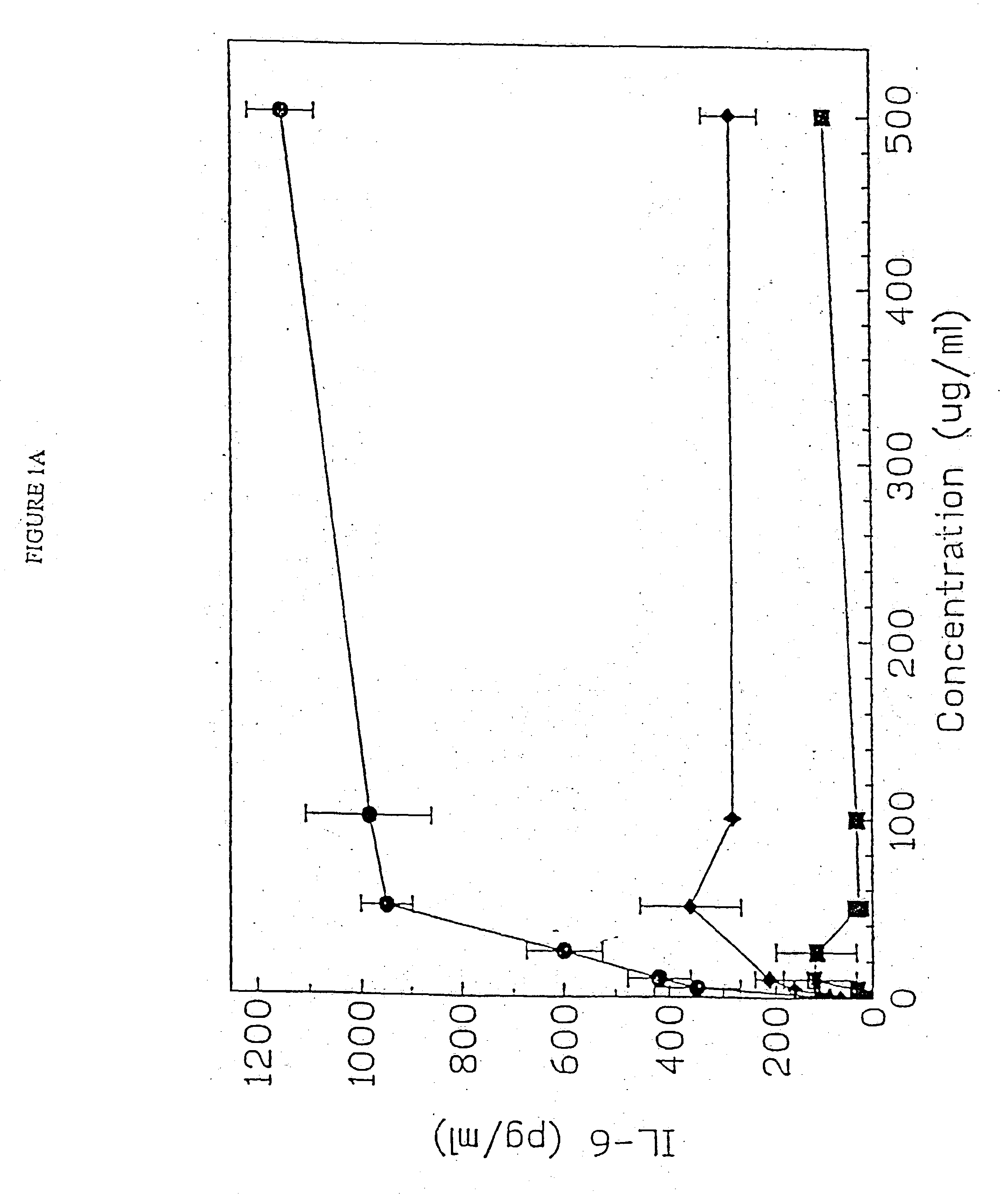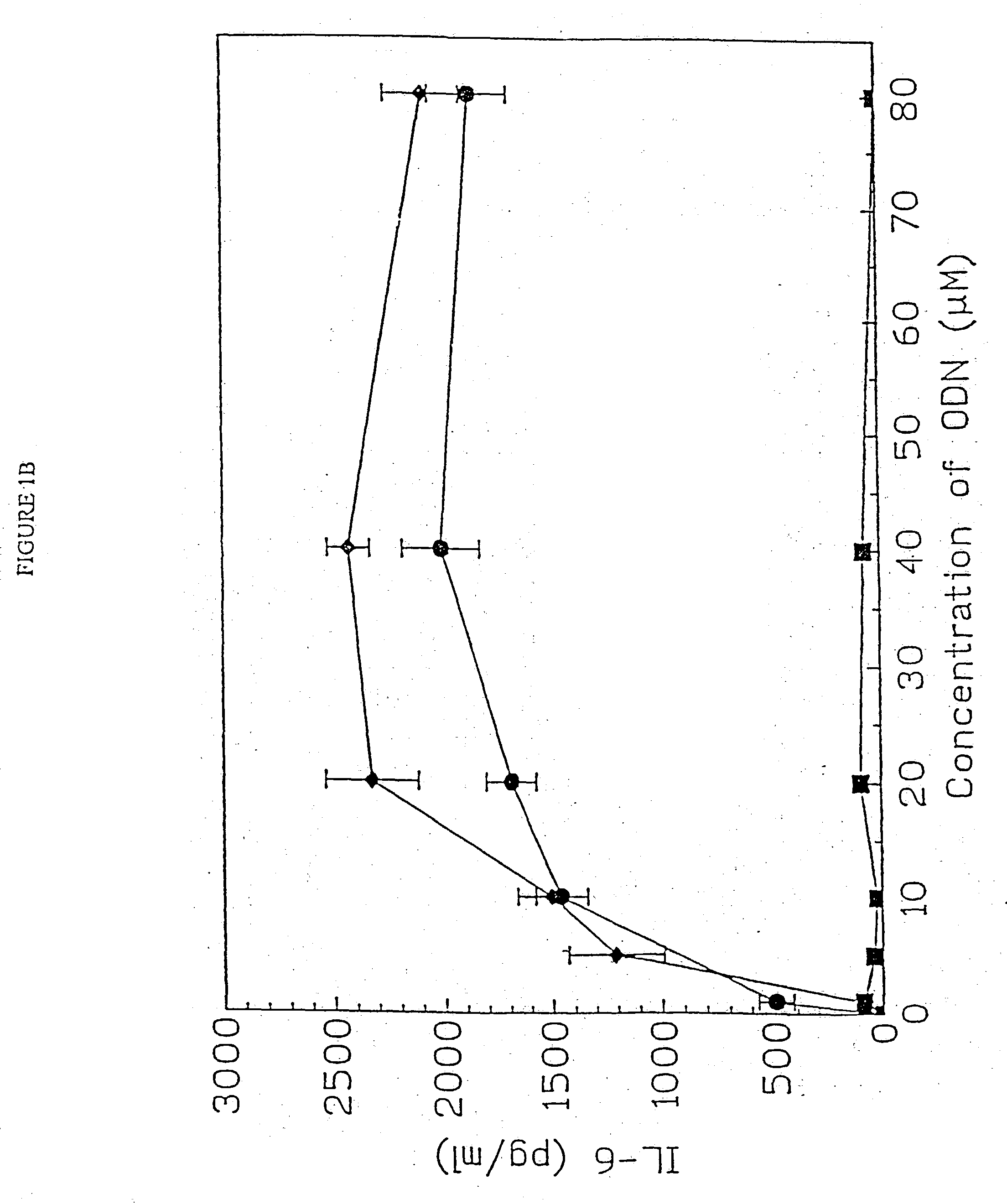Immunostimulatory nucleic acid molecules
a nucleic acid and immunosuppression technology, applied in the field of oligonucleotides, can solve problems such as poly(i,c), and achieve the effect of increasing the sensitivity of chronic leukemia cells
- Summary
- Abstract
- Description
- Claims
- Application Information
AI Technical Summary
Benefits of technology
Problems solved by technology
Method used
Image
Examples
example 2
Effects of ODN on Production of IgM from B Cells
[0155] Single cell suspensions form the spleens of freshly killed mice were treated with anti-Thy1, anti-CD4, and anti-CD8 and complement by the method of Leibson et al., J. Exp. Med. 154:1681 (1981)). Resting B cells (J. Exp. Med. 155:1523 (1982). These were cultured as described above in 30 μg / ml LPS for 48 hr. The number of B cells actively secreting IgM was maximal at this time point, as determined by ELIspot assay (Klinman, D. M. et al. J. Immunol 144:506 (1990)). In that assay, B cells were incubated for 6 hrs on anti-Ig coated microtiter plates. The Ig they produced (>99% IgM) was detected using phosphatase-labeled anti-Ig (Southern Biotechnology Associated, Birmingham, Ala.). The antibodies produced by individual B cells were visualized by addition of BCIP (Sigma Chemical Co., St. Louis Mo.) which forms an insoluble blue precipitate in the presence of phosphatase. The dilution of cells producing 20-40-spots / well was used to de...
example 3
B Cell Stimulation by Bacterial DNA
[0156] DBA / 2 B cells were cultured with no DNA or 50 μg / ml of a(Micrococcus lysodeikticus; b) NZB / N mouse spleen; and c) NSF / N mouse spleen genomic DNAs for 48 hours, then pulsed, with 3H thymidine for 4 hours prior to cell harvest. Duplicate DNA samples were digested with DNASE I for 30 minutes at 37 C prior to addition to cell cultures. E. coli DNA also induced an 8.8 fold increase in the number of IgM secreting B cells by 48 hours using the ELISAspot assay.
[0157] DBA / 2 B cells were cultured with either no additive, 50 μg / ml LPS or the ODN 1; 1a; 4; or 4a at 20 uM. Cells were cultured and harvested at 4, 8, 24 and 48 hours. BXSB cells were cultured as in Example 1 with 5, 10, 20, 40 or 80 μM of ODN 1; 1a; 4; or 4a or LPS. In this experiment, wells with no ODN had 3833 cpm. Each experiment was performed at least three times with similar results. Standard deviations of the triplicate wells were <5%.
example 4
Effects of ODN on Natural Killer (NK) Activity
[0158] 10×106 C57BL / 6 spleen cells were cultured in two ml RPMI (supplemented as described for Example 1) with or without 40 μM CpG or non-CpG ODN for forty-eight hours. Cells were washed, and then used as effector cells in a short term 51Cr release assay with YAC-1 and 2C11, two NK sensitive target cell lines (Ballas, Z. K. et al. (1993) j. IMMUNOL. 150:17). Effector cells were added at various concentrations to 104 51Cr-labeled target cells in V-bottom microtiter plates in 0.2 ml, and incubated in 5% CO2 for 4 hr. At 37° C. Plates were then centrifuged, and an aliquot of the supernatant counted for radioactivity. Percent specific lysis was determined by calculating the ratio of the 51Cr released in the presence of effector cells minus the 51Cr released when the target cells are cultured alone, over the total counts released after cell lysis in 2% acetic acid minus the 51Cr cpm released when the cells are cultured alone.
PUM
| Property | Measurement | Unit |
|---|---|---|
| composition | aaaaa | aaaaa |
| length | aaaaa | aaaaa |
| nucleic acid | aaaaa | aaaaa |
Abstract
Description
Claims
Application Information
 Login to View More
Login to View More - R&D
- Intellectual Property
- Life Sciences
- Materials
- Tech Scout
- Unparalleled Data Quality
- Higher Quality Content
- 60% Fewer Hallucinations
Browse by: Latest US Patents, China's latest patents, Technical Efficacy Thesaurus, Application Domain, Technology Topic, Popular Technical Reports.
© 2025 PatSnap. All rights reserved.Legal|Privacy policy|Modern Slavery Act Transparency Statement|Sitemap|About US| Contact US: help@patsnap.com



